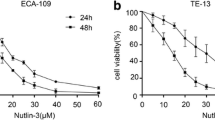Abstract
The purpose of this study was to investigate the efficacy of Endostar combined with chemotherapy on human esophageal squamous cell carcinoma Eca-109 in mice. The tumor xenograft models were established and randomly assigned to 4 groups: control group, Endostar group (1.5 mg/kg day, once daily for 3 weeks), chemotherapy group (Paclitaxel 10 mg/kg day, Cisplatin 5 mg/kg day, for 1, 7, 14, 21 days), and chemotherapy + Endostar group (combination). The length and width of tumor were measured and the tumor volumes (cm3) were calculated every other day. Three weeks later, the mice were executed, and the tumor tissues were collected to weigh and analyse the histopathology and proliferation for tumor xenograft. The results demonstrated that the tumor volumes and weight in chemotherapy + Endostar group were significantly lower than that in other three groups. Meanwhile, the cell proliferation of tumor xenograft in combined treatment group was significantly lower than that in other three groups. It was concluded that Endostar combined with chemotherapy could obviously enhance the inhibitory effect on esophageal squamous cell carcinoma Eca-109 in mice.


Similar content being viewed by others
References
Abrams JA, Sharaiha RZ, Gonsalves L, Lightdale CJ, Neugut AI (2011) Dating the rise of esophageal adenocarcinoma: analysis of Connecticut Tumor Registry data, 1940–2007. Cancer Epidemiol Biomarkers Prev 20(1):183–186. doi:10.1158/1055-9965.EPI-10-0802
Sheyhidin I, Nabi G, Hasim A, Zhang RP, Ainiwaer J, Ma H, Wang H (2011) Overexpression of TLR3, TLR4, TLR7 and TLR9 in esophageal squamous cell carcinoma. World J Gastroenterol 17(32):3745–3751. doi:10.3748/wjg.v17.i32.3745
Yang H, Sukocheva OA, Hussey DJ, Watson DI (2012) Estrogen, male dominance and esophageal adenocarcinoma: is there a link? World J Gastroenterol 18(5):393–400. doi:10.3748/wjg.v18.i5.393
Zhang L, Ge W, Hu K et al (2012) Endostar down-regulates HIF-1 and VEGF expression and enhances the radioresponse to human lung adenocarcinoma cancer cells. Mol Biol Rep 39(1):89–95. doi:10.1007/s11033-011-0713-6
Ling Y, Yang Y, Lu N, You Q (2007) Endostar, a novel recombinant human endostatin, exerts antiangiogenic blocking VEGF-induced tyrosine phosphorylation of KDR/Flk-1 of endothelial cells. Biochem Biophys Res Commun 361(1):79–84. doi:10.1016/j.bbrc.2007.06.155
Jia Y, Liu M, Huang W et al (2012) Recombinant human endostatin endostar inhibits tumor growth and metastasis in a mouse xenograft model of colon cancer. Pathol Oncol Res 18(2):315–323. doi:10.1007/s12253-011-9447-y
Li Y, Huang XE, Yan PW, Jiang Y, Xiang J (2010) Efficacy and safety of endostar combined with chemotherapy in patients with advanced solid tumors. Asian Pac J Cancer Prev 11(4):1119–1123
Zhou N, Hu G, Mei Q, Qiu H, Long G, Chen C, Guoqing H (2011) Inhibitory effect of endostar in combination with radiotherapy in a mouse model of human CNE2 nasopharyngeal carcinoma. J Huazhong Univ Sci Technolog Med Sci 31(1):62–66. doi:10.1007/s11596-011-0151-7
Fu XH, Li J, Zou Y, Hong YR, Fu ZX, Huang JJ, Zhang SZ, Zheng S (2011) Endostar enhances the antineoplastic effects of combretastatin A4 phosphate in an osteosarcoma xenograft. Cancer Lett 312(1):109–116
Kisker O, Becker CM, Prox D et al (2001) Continuous administration of endostatin by intraperitoneally implanted osmotic pump improves the efficacy and potency of therapy in a mouse xenograft tumor model. Cancer Res 61(20):7669–7674
Yoon SS, Eto H, Lin CM, Nakamura H, Pawlik TM, Song SU, Tanabe KK (1999) Mouse endostatin inhibits the formation of lung and liver metastases. Cancer Res 59(24):6251–6256
Zhan Q, Yue W, Hu S (2011) Effect of photodynamic therapy and endostatin on human glioma xenografts in nude mice. Photodiagnosis Photodyn Ther 8(4):314–320
Hu S, Zhang Y (2010) Endostar-loaded PEG-PLGA nanoparticles: in vitro and in vivo evaluation. Int J Nanomedicine 5:1039–1048
Sun Y, Wang J, Liu Y et al (2005) Results of phase III trial of rh-endostatin (YH-16) in advanced non-small cell lung cancer (NSCLC) patients. J Clin Oncol 23(16S):7138; Abstract presentation from the 2005 ASCO Annual Meeting
Wu H, Deng J, Yu SY, Wang X, Chen Y (2010) The Inhibitory effects of rh-endostatin (YH-16) in combination with radiotherapy on lung adenocarcinoma A549 in mice and the underlying mechanisms. J Huazhong Univ Sci Technolog Med Sci 30(1):108–112. doi:10.1007/s11596-010-0120-6
Zhen YY, Zhao Y, Liu F, Zhang YD, Wang JJ (2010) The radiosensitization effects of endostar on human lung squamous cancer cells H-520. Cancer Cell Int 24:17–26. doi:10.1186/1475-2867-10-17
Wen QL, Meng MB, Yang B, Tu LL, Jia L, Zhou L, Xu Y, Lu Y (2009) Endostar, a recombined humanized endostatin, enhances the radioresponse for human nasopharyngeal carcinoma and human lung adenocarcinoma xenografts in mice. Cancer Sci 100(8):1510–1519. doi:10.1111/j.1349-7006.2009.01193.x
Peng F, Xu Z, Wang J et al (2012) Recombinant human endostatin normalizes tumor vasculature and enhances radiation response in xenografted human nasopharyngeal carcinoma models. PLoS One 7(4):e34646
Wu DS, Wu CM, Huang TH, Xie QD (2008) Combined effects of radiotherapy and endostatin gene therapy in melanoma tumor model. Radiat Environ Biophys 47(2):285–291. doi:10.1007/s00411-007-0144-x
Zhou JF, Bai CM, Wang YZ, Li XY, Cheng YJ, Chen SC (2011) Endostar combined with chemotherapy for treatment of metastatic colorectal and gastric cancer: a pilot study. Chin Med J (Engl) 124(24):4299–4303
Ge W, Cao DD, Wang HM, Jie FF, Zheng YF, Chen Y (2011) Endostar combined with chemotherapy versus chemotherapy alone for advanced NSCLCs: a meta-analysis. Asian Pac J Cancer Prev 12(10):2705–2711
Peng XC, Qiu M, Wei M et al (2012) Different combination schedules of gemcitabine with endostar affect antitumor efficacy. Cancer Chemother Pharmacol 69(1):239–246. doi:10.1007/s00280-011-1695-8
Deng G, Zhao DL, Li GC, Yu H, Teng GJ (2011) Combination therapy of transcatheter arterial chemoembolization and arterial administration of antiangiogenesis on VX2 liver tumor. Cardiovasc Intervent Radiol 34(4):824–832. doi:10.1007/s00270-011-0179-x
Acknowledgments
This work was supported by the International Medical Foundation of China (CIMF-F-H001-049).
Author information
Authors and Affiliations
Corresponding author
Additional information
Liang Chang and Fengjie Guo have contributed equally to this work.
Rights and permissions
About this article
Cite this article
Chang, L., Guo, F., Lv, Y. et al. The inhibitory effects of Endostar combined with chemotherapy on human esophageal squamous cell carcinoma xenograft in mice. Mol Biol Rep 40, 669–673 (2013). https://doi.org/10.1007/s11033-012-2106-x
Received:
Accepted:
Published:
Issue Date:
DOI: https://doi.org/10.1007/s11033-012-2106-x




